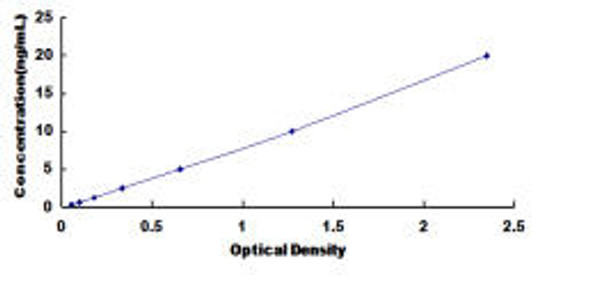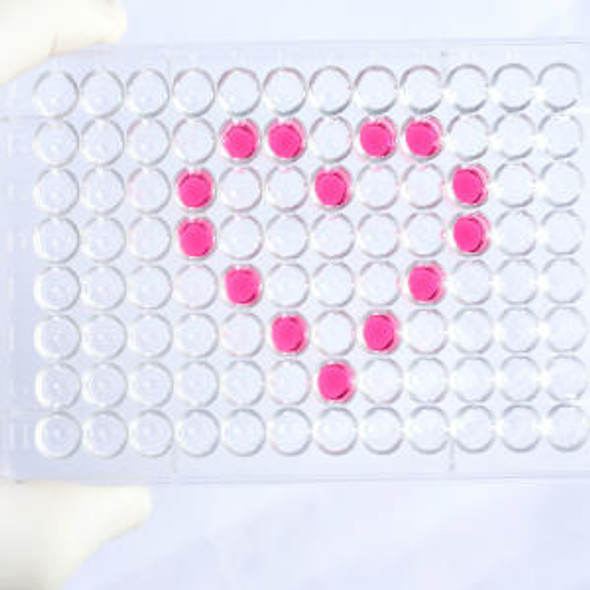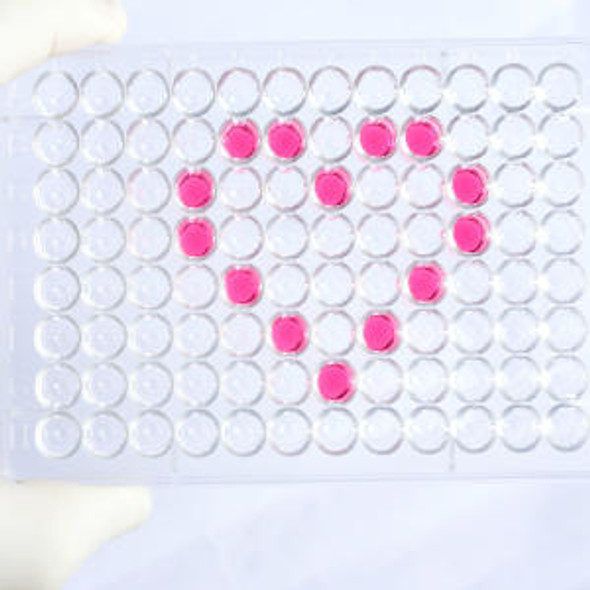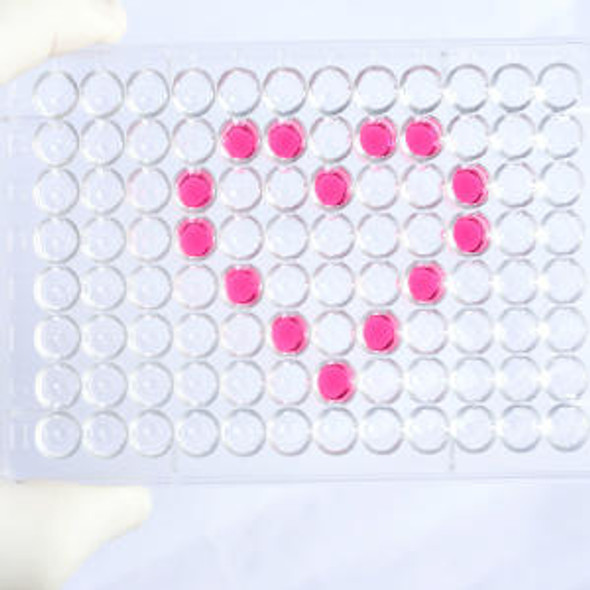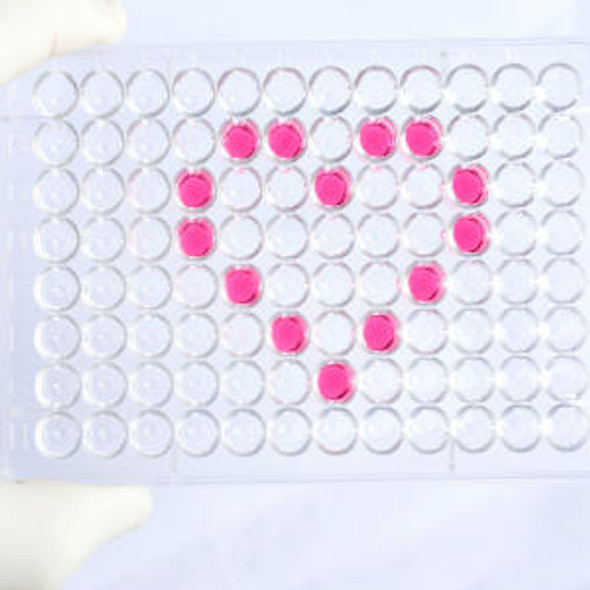Human Signal Transduction ELISA Kits
Human MRP1 (Multidrug Resistance Associated Protein 1) CLIA Kit (HUES01088)
- SKU:
- HUES01088
- Product Type:
- ELISA Kit
- ELISA Type:
- CLIA Kit
- Size:
- 96 Assays
- Sensitivity:
- 37.5pg/mL
- Range:
- 62.5-4000pg/mL
- ELISA Type:
- Sandwich
- Reactivity:
- Human
- Sample Type:
- Serum, plasma and other biological fluids
- Research Area:
- Signal Transduction
Description
| Assay type: | Sandwich |
| Format: | 96T |
| Assay time: | 4.5h |
| Reactivity: | Human |
| Detection method: | Chemiluminescence |
| Detection range: | 62.50-4000 pg/mL |
| Sensitivity: | 37.50 pg/mL |
| Sample volume: | 100µL |
| Sample type: | Serum, plasma and other biological fluids |
| Repeatability: | CV < 15% |
| Specificity: | This kit recognizes Human MRP1 in samples. No significant cross-reactivity or interference between Human MRP1 and analogues was observed. |
This kit uses Sandwich-CLIA as the method. The micro CLIA plate provided in this kit has been pre-coated with an antibody specific to Human MRP1. Standards or samples are added to the appropriate micro CLIA plate wells and combined with the specific antibody. Then a biotinylated detection antibody specific for Human MRP1 and Avidin-Horseradish Peroxidase (HRP) conjugate are added to each micro plate well successively and incubated. Free components are washed away. The substrate solution is added to each well. Only those wells that contain Human MRP1, biotinylated detection antibody and Avidin-HRP conjugate will appear fluorescence. The Relative light unit (RLU) value is measured spectrophotometrically by the Chemiluminescence immunoassay analyzer. The RLU value is positively associated with the concentration of Human MRP1. The concentration of Human MRP1 in the samples can be calculated by comparing the RLU of the samples to the standard curve.
| UniProt Protein Function: | ABCC1: a multi-pass membrane protein. A multidrug resistance member of the ABC transporter family that confers resistance to anticancer drugs. A multi-pass membrane protein. Exports sphingosine-1-phosphate (S1P), a potent inflammatory mediator, from mast cells during mast cell-mediated immune responses. Nine alternatively spliced human isoforms have been reported. |
| UniProt Protein Details: | Protein type:Membrane protein, multi-pass; Membrane protein, integral; Transporter, ABC family; Transporter Chromosomal Location of Human Ortholog: 16p13. 1 Cellular Component: membrane; integral to plasma membrane; plasma membrane Molecular Function:ATPase activity, coupled to transmembrane movement of substances; transporter activity; ATPase activity; ATP binding Biological Process: response to drug; vitamin metabolic process; transport; cobalamin metabolic process; arachidonic acid metabolic process; leukotriene metabolic process; transmembrane transport; water-soluble vitamin metabolic process |
| NCBI Summary: | The protein encoded by this gene is a member of the superfamily of ATP-binding cassette (ABC) transporters. ABC proteins transport various molecules across extra-and intra-cellular membranes. ABC genes are divided into seven distinct subfamilies (ABC1, MDR/TAP, MRP, ALD, OABP, GCN20, White). This full transporter is a member of the MRP subfamily which is involved in multi-drug resistance. This protein functions as a multispecific organic anion transporter, with oxidized glutatione, cysteinyl leukotrienes, and activated aflatoxin B1 as substrates. This protein also transports glucuronides and sulfate conjugates of steroid hormones and bile salts. Alternatively spliced variants of this gene have been described but their full-length nature is unknown. [provided by RefSeq, Apr 2012] |
| UniProt Code: | P33527 |
| NCBI GenInfo Identifier: | 296439301 |
| NCBI Gene ID: | 4363 |
| NCBI Accession: | P33527. 3 |
| UniProt Secondary Accession: | P33527,O14819, O43333, P78419, Q59GI9, Q9UQ97, Q9UQ99 Q9UQA0, A3RJX2, C9JPJ4, |
| UniProt Related Accession: | P33527 |
| Molecular Weight: | 1531 |
| NCBI Full Name: | Multidrug resistance-associated protein 1 |
| NCBI Synonym Full Names: | ATP-binding cassette, sub-family C (CFTR/MRP), member 1 |
| NCBI Official Symbol: | ABCC1 |
| NCBI Official Synonym Symbols: | MRP; ABCC; GS-X; MRP1; ABC29 |
| NCBI Protein Information: | multidrug resistance-associated protein 1; LTC4 transporter; leukotriene C(4) transporter; ATP-binding cassette transporter variant ABCC1delta-ex13; ATP-binding cassette transporter variant ABCC1delta-ex25; ATP-binding cassette transporter variant ABCC1de |
| UniProt Protein Name: | Multidrug resistance-associated protein 1 |
| UniProt Synonym Protein Names: | ATP-binding cassette sub-family C member 1; Leukotriene C(4) transporter; LTC4 transporter |
| Protein Family: | 37S ribosomal protein |
| UniProt Gene Name: | ABCC1 |
| UniProt Entry Name: | MRP1_HUMAN |
As the RLU values of the standard curve may vary according to the conditions of the actual assay performance (e. g. operator, pipetting technique, washing technique or temperature effects), the operator should establish a standard curve for each test. Typical standard curve and data is provided below for reference only.
| Concentration (pg/mL) | RLU | Average | Corrected |
| 4000 | 58073 60089 | 59081 | 59046 |
| 2000 | 26686 29032 | 27859 | 27824 |
| 1000 | 14309 12659 | 13484 | 13449 |
| 500 | 6139 7071 | 6605 | 6570 |
| 250 | 3495 2991 | 3243 | 3208 |
| 125 | 1695 1467 | 1581 | 1546 |
| 62.50 | 718 792 | 755 | 720 |
| 0 | 35 35 | 35 | -- |
Precision
Intra-assay Precision (Precision within an assay): 3 samples with low, mid range and high level Human MRP1 were tested 20 times on one plate, respectively.
Inter-assay Precision (Precision between assays): 3 samples with low, mid range and high level Human MRP1 were tested on 3 different plates, 20 replicates in each plate.
| Intra-assay Precision | Inter-assay Precision | |||||
| Sample | 1 | 2 | 3 | 1 | 2 | 3 |
| n | 20 | 20 | 20 | 20 | 20 | 20 |
| Mean (pg/mL) | 200.99 | 449.13 | 1771.68 | 219.19 | 485.85 | 1899.14 |
| Standard deviation | 20.60 | 35.98 | 181.95 | 18.46 | 40.08 | 179.85 |
| C V (%) | 10.25 | 8.01 | 10.27 | 8.42 | 8.25 | 9.47 |
Recovery
The recovery of Human MRP1 spiked at three different levels in samples throughout the range of the assay was evaluated in various matrices.
| Sample Type | Range (%) | Average Recovery (%) |
| Serum (n=5) | 93-107 | 99 |
| EDTA plasma (n=5) | 93-107 | 100 |
| Cell culture media (n=5) | 94-108 | 101 |
Linearity
Samples were spiked with high concentrations of Human MRP1 and diluted with Reference Standard & Sample Diluent to produce samples with values within the range of the assay.
| Serum (n=5) | EDTA plasma (n=5) | Cell culture media (n=5) | ||
| 1:2 | Range (%) | 88-99 | 101-115 | 84-98 |
| Average (%) | 94 | 109 | 90 | |
| 1:4 | Range (%) | 89-103 | 100-114 | 97-113 |
| Average (%) | 95 | 107 | 104 | |
| 1:8 | Range (%) | 99-111 | 97-109 | 98-111 |
| Average (%) | 104 | 102 | 105 | |
| 1:16 | Range (%) | 92-105 | 95-110 | 85-97 |
| Average (%) | 99 | 101 | 91 |
An unopened kit can be stored at 4°C for 1 month. If the kit is not used within 1 month, store the items separately according to the following conditions once the kit is received.
| Item | Specifications | Storage |
| Micro CLIA Plate(Dismountable) | 8 wells ×12 strips | -20°C, 6 months |
| Reference Standard | 2 vials | |
| Concentrated Biotinylated Detection Ab (100×) | 1 vial, 120 µL | |
| Concentrated HRP Conjugate (100×) | 1 vial, 120 µL | -20°C(shading light), 6 months |
| Reference Standard & Sample Diluent | 1 vial, 20 mL | 4°C, 6 months |
| Biotinylated Detection Ab Diluent | 1 vial, 14 mL | |
| HRP Conjugate Diluent | 1 vial, 14 mL | |
| Concentrated Wash Buffer (25×) | 1 vial, 30 mL | |
| Substrate Reagent A | 1 vial, 5 mL | 4°C (shading light) |
| Substrate Reagent B | 1 vial, 5 mL | 4°C (shading light) |
| Plate Sealer | 5 pieces | |
| Product Description | 1 copy | |
| Certificate of Analysis | 1 copy |
- Set standard, test sample and control (zero) wells on the pre-coated plate and record theirpositions. It is recommended to measure each standard and sample in duplicate. Note: addall solutions to the bottom of the plate wells while avoiding contact with the well walls. Ensuresolutions do not foam when adding to the wells.
- Aliquot 100 µL of standard solutions into the standard wells.
- Add 100 µL of Sample / Standard dilution buffer into the control (zero) well.
- Add 100 µL of properly diluted sample (serum, plasma, tissue homogenates and otherbiological fluids. ) into test sample wells.
- Cover the plate with the sealer provided in the kit and incubate for 90 min at 37 °C.
- Aspirate the liquid from each well, do not wash. Immediately add 100 µL of BiotinylatedDetection Ab working solution to each well. Cover the plate with a plate seal and gently mix. Incubate for 1 hour at 37 °C.
- Aspirate or decant the solution from the plate and add 350 µL of wash buffer to each welland incubate for 1-2 minutes at room temperature. Aspirate the solution from each well andclap the plate on absorbent filter paper to dry. Repeat this process 3 times. Note: a microplatewasher can be used in this step and other wash steps.
- Add 100 µL of HRP Conjugate working solution to each well. Cover with a plate seal andincubate for 30 min at 37 °C.
- Aspirate or decant the solution from each well. Repeat the wash process for five times asconducted in step 7.
- Add 100 µL of Substrate mixture solution to each well. Cover with a new plate seal andincubate for no more than 5 min at 37 °C. Protect the plate from light.
- Determine the RLU value of each well immediately.


